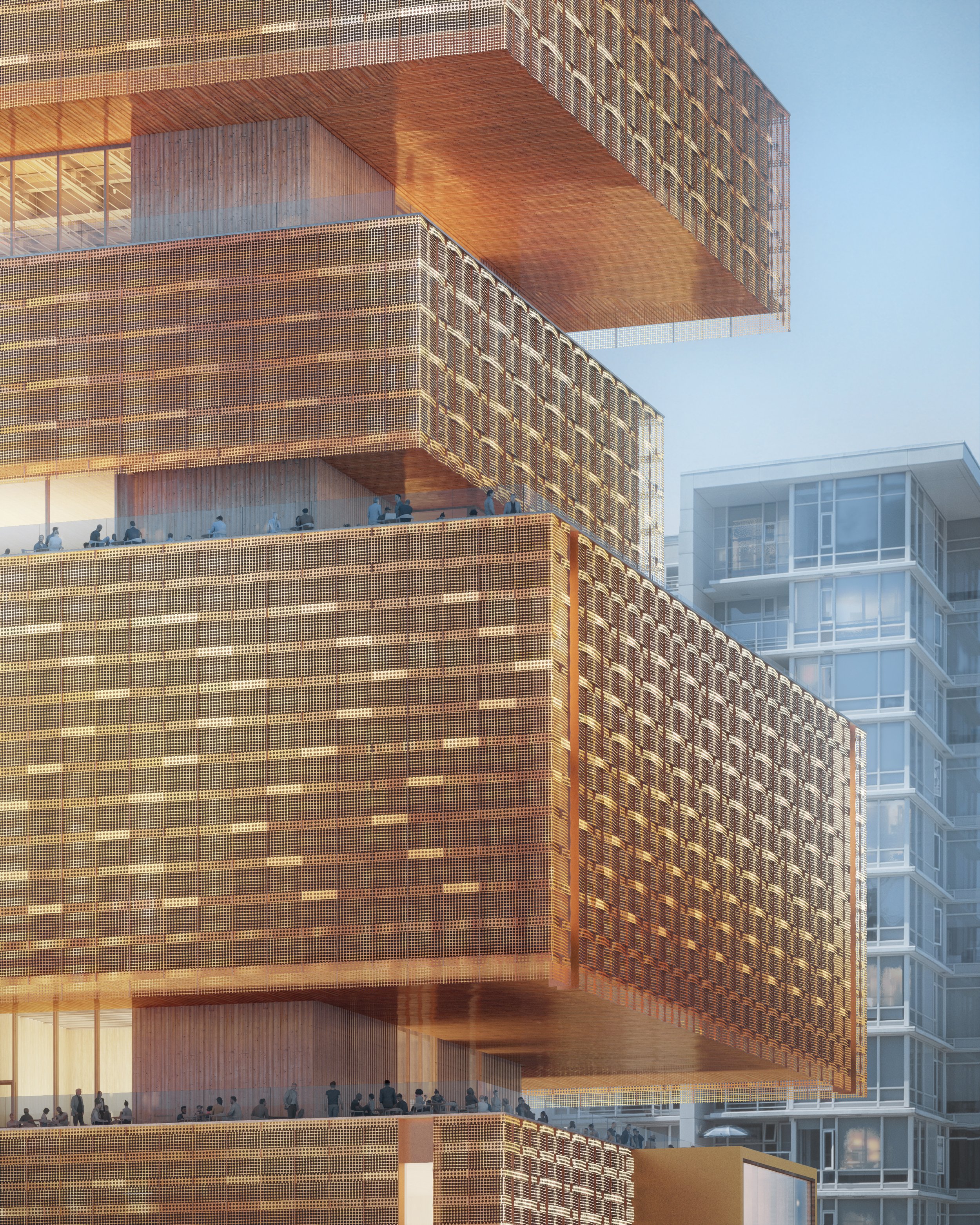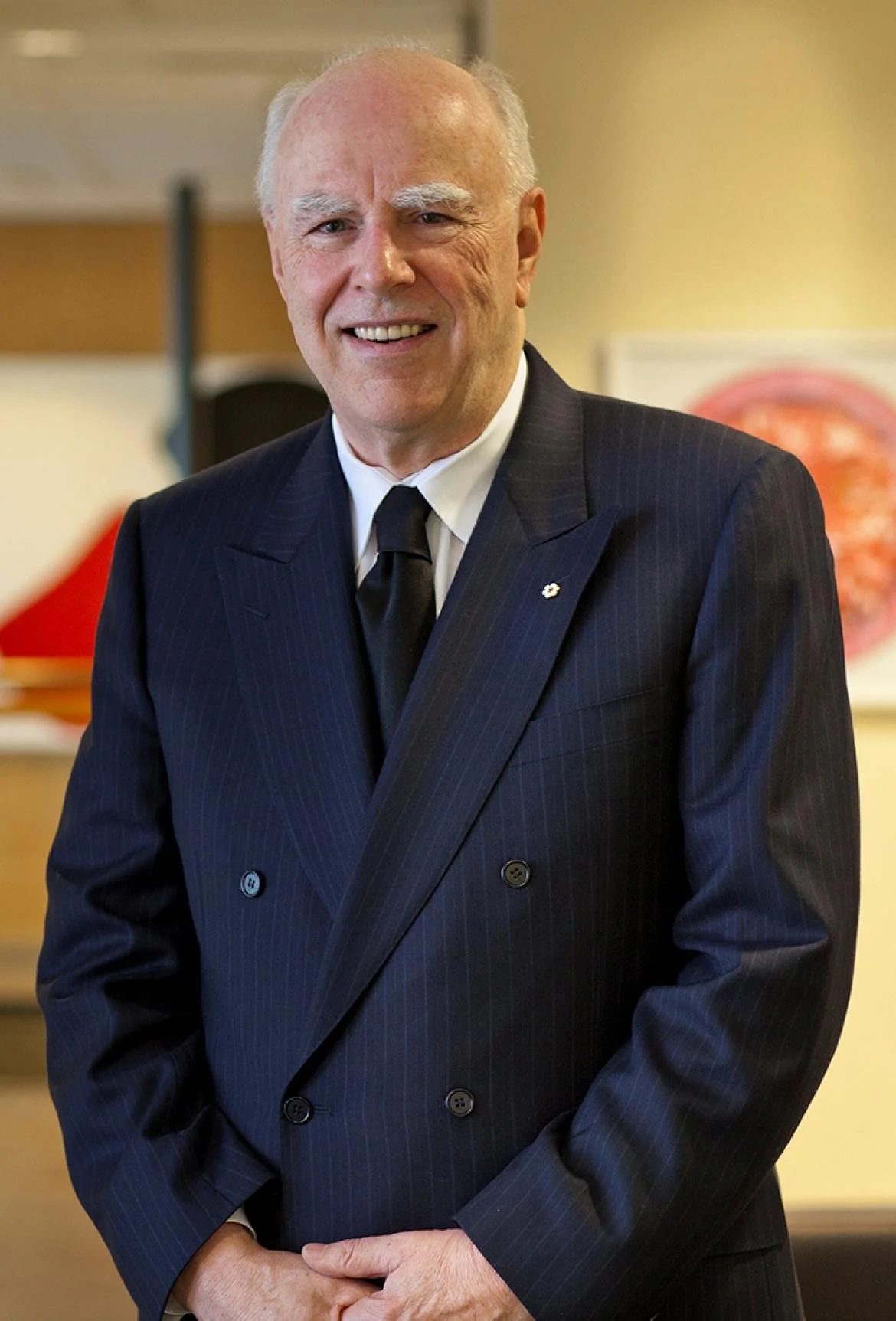Redesigned copper cladding for new Vancouver Art Gallery site, as Audain Foundation makes record-setting $100 million donation
Architects have worked with Coast Salish weavers to change exterior plans
Herzog & de Meuron's new rendering of an exterior that references Coast Salish weaving.
Herzog & de Meuron's previous rendering for the Vancouver Art Gallery from 2019.
THE AUDAIN FOUNDATION has just donated $100 million toward the construction of a new Vancouver Art Gallery at West Georgia and Cambie Streets, the largest donation to the arts in Canadian history.
“This puts the wind in our sails and says, ‘This is going to happen,’” VAG CEO and director Anthony Kiendl said at the press conference at the current gallery site today. He added the long-planned project could break ground as soon as next year, with a completion goal of 2026. “We are seeking to raise an additional $160 million from other sources.”
Michael Audain
“Our federal government needs to come to the party very quickly,” the foundation’s chair, philanthropist and developer Michael Audain, told the press today. “When one considers Ottawa’s generous support for art gallery buildings in other parts of Canada, I am frankly puzzled that they have not yet indicated support for this project in one of Canada’s largest cities.”
The announcement today at the VAG also included dramatic changes to the design plan for the 330,000-square-foot facility from Swiss-based architectural firm Herzog & de Meuron. Working with BC Coast Salish weavers, the team is now proposing the building be clad in a copper or copperlike metal “veil” that is woven to reference traditional Indigenous blankets from this region; the soffits feature prominent wood.
“Now we are offered the opportunity to get involved in the construction of a brilliantly designed new art gallery which, most importantly, will incorporate the artistic traditions of the original people of the Northwest Coast,” Audain said. “It’s been great to have a re-evaluation of the design and see it corresponding to the traditions of the First Nations of the area.”
The copper veil differs from previous renderings. The original, in 2015, caused a stir when it featured full wood cladding. A later design, which coincided with 2019’s $40 million donation from Vancouver’s Chan family, introduced full glass to the exterior of the building at Larwill Park.
Local Musqueam artist and weaver Debra Sparrow, who has joined Indigenous artists Chepximiya Siyam’ Janice George, Skwetsimeltxw Willard ‘Buddy’ Joseph, and Angela George as art and design consultants on the project since March 2021, welcomed the new design.
”We have come through a dark time as Indigenous people but this shines a light on what we know of the City of Vancouver,” she said, adding the design “takes weaving to another level. I am not in awe of most things but I am in awe of this building because it represents so much.”
The shift in direction on the outside of the building reflects changes that have come during a year of pandemic reflection and changes under the new leadership of Kiendl, CEO and director since August 2020. He succeeded interim director Daina Augaitis, who took the helm in May 2019 when Kathleen Bartels departed the VAG after 18 years. The same Coast Salish weaving that inspired the new design takes a prominent spot in the Vancouver Special: Disorientations and Echo exhibit on view now—a show devoted to displaying racialized and marginalized voices that may not have found a place in the gallery before. The VAG’s new focus on BIPOC artists joins a larger movement to decolonize Canadian arts institutions—and now, that process will be reflected inside and outside the facility.
The reimagined tower now features a large top slab. Rendering by Herzog & de Meuron
“One of the things I admire about the exterior is that there are qualities to it of visual excitement and transformation,” Kiendl told Stir, explaining the woven copper will cover both opaque and glass parts of the building, and will shift in appearance in different light and different proximities. “It really in that way reflects the Coast Salish blankets, which I learned, if you hang them horizontally or vertically, they can look very different—there’s literally a visual transformation that happens.
“And to me that’s such a great analogy or metaphor for art—they represent how humans can take a very everyday material like goat hair or dog hair, fabricate it in an ingenious way, and literally make something that transforms your perception of the world,” Kiendl continued. “When people wear these blankets there’s not only that visual transformation but then it takes on also spiritual transformation, and they are really incredibly powerful objects.”
He emphasized the new facility will double the gallery’s exhibition space, giving more room to display art that defines this place: “This is the story of BC art and Canadian art.”
The facility will incorporate over 80,000 square feet of exhibition space in all, half of which is dedicated to the gallery’s permanent collection. The new building also encompasses two free-access galleries; a 300-seat theatre; four classrooms; a gallery store and restaurant; and more. It will also provide the physical home for the Institute of Asian Art, including South Asian and Central Asian works. The outdoor space includes a 40,000-square-foot courtyard.
In all, the new building provides visible and safe storage for more than 12,000 works of art in the permanent collection, including major Canadian artists such as Emily Carr.
The new VAG site will also incorporate rigorous Passivhaus energy standards of sustainability—making it the first gallery in North America to do so.
“The fact that the building will be highly sustainable must also be of special interest during this week’s Climate Change conference in Glasgow,” Audain said.
Herzog & de Meuron architect Simon Demeuse explained the tower’s actual structure has also been modified to create more art spaces within the vertical. (The size has increased by 30,000 square feet accordingly.) He pointed out the new, prominent slab that now tops the design, instead of the smaller, Jenga-like block of previous designs. “It’s a very symmetrical upright building that gives it a very civic scale,” Demeuse said of the new design, which is still being developed.
The site will now include artists’ studios and accommodation and expanded community-art spaces.
Audain stressed the importance of educational facilities for school groups at the new institution. “I’m delighted by the changes—not only the new look of the building but also it’s more functional on the inside,” Audain commented. “I’m also in the construction industry and of course it’s become more efficient to build.”
Overall, the announcement marks a big leap in progress for a project that has been in the works for more than a decade. The last big donation toward it came as a $1.5 million capital campaign gift from Donald Ellis, a longtime supporter of the gallery, in 2020. Audain said he was inspired particularly by the 2019 $40 million gift from the Chan family—at that time the largest-ever single private donation to an arts and culture organization in British Columbia. Their name has been attached to the building itself, the Chan Centre for the Visual Arts.
The $400-million project already has a contribution from the B.C. government of $50 million and the City of Vancouver’s land, donated for the site, is valued at more than $100-million.
















